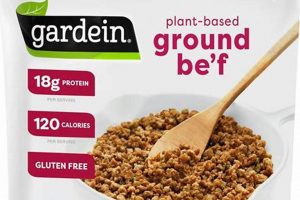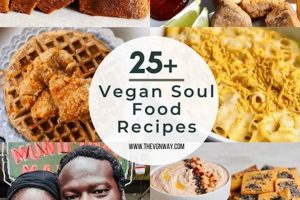Vitamin B6, also known as pyridoxine, is an essential nutrient that plays a crucial role in various bodily functions, including brain development, immune function, and the metabolism of proteins, fats, and carbohydrates. Individuals adhering to plant-based diets can readily obtain this vital vitamin through diverse dietary sources that align with their vegan lifestyle. Examples include specific fruits, vegetables, legumes, and fortified products.
Adequate consumption of this nutrient is paramount for maintaining overall health and well-being. It supports the production of neurotransmitters, which are essential for cognitive function and mood regulation. Moreover, it contributes to the formation of red blood cells, which are vital for oxygen transport throughout the body. Throughout history, the recognition of vitamin B6’s significance has led to increased awareness of the importance of nutrient-rich diets, particularly for those following restricted eating patterns.
The subsequent sections will delve into the specific food items that offer considerable amounts of this vitamin, suitable meal planning strategies, and methods to ensure sufficient intake for individuals who maintain a completely plant-based dietary approach.
The following guidance addresses strategies for ensuring adequate vitamin B6 consumption through exclusively plant-derived sources. This is particularly relevant for individuals committed to a vegan lifestyle who must strategically select nutrient-dense foods.
Tip 1: Prioritize chickpeas. This legume represents a significant source of vitamin B6. Integrate chickpeas into meals through hummus, salads, or roasted as a snack.
Tip 2: Incorporate fortified cereals. Select breakfast cereals that have been specifically fortified with vitamin B6. Examine the nutrition labels to confirm appropriate levels.
Tip 3: Utilize potatoes strategically. Potatoes, particularly with the skin intact, provide a notable amount of vitamin B6. Baking or steaming preserves more nutrients than frying.
Tip 4: Explore plant-based milk alternatives. Certain plant-based milk options, such as those derived from soy or oats, may be fortified with vitamin B6. Compare nutritional profiles to identify optimal choices.
Tip 5: Include dark leafy greens. While not as concentrated a source as some other options, dark leafy greens like spinach and kale contribute to overall vitamin B6 intake within a balanced diet.
Tip 6: Consider incorporating bananas. This fruit provides a moderate amount of vitamin B6 and can be easily integrated into snacks, smoothies, or breakfasts.
These strategies, when implemented consistently, can contribute to maintaining adequate vitamin B6 levels within a vegan dietary framework. Diligence in food selection and meal planning is crucial for optimizing nutritional intake.
The subsequent sections will provide further insights into potential deficiencies and methods for monitoring vitamin B6 levels.
1. Chickpeas abundant source
Chickpeas, as a significant component of diets emphasizing “b6 foods vegan,” directly address the nutritional needs of individuals adhering to plant-based eating patterns. The inherent link lies in the cause-and-effect relationship: the consumption of chickpeas directly results in an increased intake of vitamin B6. This is crucial because vitamin B6 is an essential nutrient, and chickpeas offer a readily available and easily incorporated source for vegans. A practical example is the inclusion of hummus, a chickpea-based spread, in vegan meals, providing both nutritional benefits and culinary versatility. The importance of this understanding stems from the need to ensure adequate nutrient intake within a restricted dietary framework.
Further analysis reveals that chickpeas are not only a source of vitamin B6 but also provide other essential nutrients, such as fiber and protein, contributing to overall dietary adequacy. The integration of chickpeas into various meal types, including salads, soups, and main courses, demonstrates their adaptability and their capacity to support a balanced vegan diet. This practical application is exemplified by numerous vegan recipes that feature chickpeas as a primary ingredient, highlighting their role in providing both substance and nutritional value. This is particularly significant as it addresses potential concerns regarding nutrient deficiencies often associated with restrictive diets.
In summary, the link between “Chickpeas abundant source” and “b6 foods vegan” underscores the importance of strategic food selection in plant-based diets. The consistent incorporation of chickpeas into vegan meal plans directly contributes to meeting vitamin B6 requirements and supports overall nutritional well-being. Challenges may arise in consistently consuming adequate amounts, necessitating careful meal planning and awareness of nutritional needs. Understanding this connection facilitates informed dietary choices and contributes to the long-term sustainability of a healthy vegan lifestyle.
2. Potatoes with skin
The correlation between consuming potatoes with the skin intact and adhering to a b6 foods vegan diet is direct and nutritionally significant. Leaving the skin on potatoes during preparation enhances vitamin B6 intake. The potato skin contains a considerable portion of the vitamin B6 present in the vegetable. Therefore, the method of preparation directly influences the nutritional value derived. A practical example is illustrated by comparing two identical potatoes, one baked with its skin and the other peeled before baking. The former will invariably provide a higher dose of vitamin B6. This dietary strategy is of importance for individuals pursuing a vegan lifestyle to optimize nutrient absorption from available plant-based sources.
Further analysis reveals that retaining the potato skin not only increases vitamin B6 content but also augments the fiber content. Fiber is an essential component of a healthy diet, aiding in digestive health and contributing to satiety. This dual benefit makes potatoes with skin a valuable addition to vegan meal planning. For instance, a vegan shepherd’s pie utilizing mashed potatoes with the skin provides both necessary nutrients and a satisfying texture. Challenges may arise from varying consumer preferences for texture, requiring innovative approaches to preparation such as thinly slicing and crisping the skin.
In conclusion, the connection between “potatoes with skin” and “b6 foods vegan” underscores a straightforward yet impactful strategy for maximizing nutrient intake. Consuming potatoes with their skin intact is a practical and accessible method for vegans to increase their vitamin B6 consumption. While textural preferences may present challenges, the nutritional advantages warrant prioritizing this preparation method within a balanced vegan diet, particularly for those seeking readily available and versatile sources of this essential vitamin. Understanding and implementing this principle contributes directly to the nutritional adequacy of plant-based diets.
3. Fortified Cereals Enhanced
The concept of “Fortified Cereals Enhanced” directly relates to the “b6 foods vegan” strategy by providing an accessible and consistent source of vitamin B6, a nutrient often requiring careful consideration in plant-based diets. The enhancement process involves the addition of synthetic vitamin B6 to breakfast cereals, thereby increasing their nutritional value and offering a readily available option for vegans to supplement their intake.
- Accessibility and Convenience
Fortified cereals are widely available in most grocery stores, making them a convenient option for individuals following a vegan diet. Their ease of preparation and integration into daily routines further enhances their appeal as a reliable source of vitamin B6. For instance, incorporating a bowl of fortified cereal into breakfast provides a consistent dose of the nutrient, simplifying dietary planning.
- Standardized Nutrient Levels
The fortification process allows for precise control over the amount of vitamin B6 added to the cereal. This standardization ensures a consistent and predictable intake of the nutrient with each serving. This is particularly beneficial for vegans who may rely on these cereals to meet a specific percentage of their daily vitamin B6 requirements. Nutrition labels clearly display the vitamin B6 content per serving, enabling informed dietary choices.
- Absorption Considerations
While fortified cereals offer a readily available source of vitamin B6, factors influencing nutrient absorption must be considered. The bioavailability of synthetic vitamin B6 can vary depending on individual metabolic factors and the presence of other dietary components. Consuming fortified cereals with other nutrient-rich foods may optimize absorption. Individuals with known absorption issues may require further evaluation and potential supplementation.
- Product Variety and Dietary Preferences
The market offers a wide variety of fortified cereals catering to diverse dietary preferences, including options low in sugar, high in fiber, or containing specific grains. Vegans can select cereals that align with their individual needs and preferences, ensuring a palatable and sustainable approach to nutrient supplementation. Careful examination of ingredient lists is crucial to confirm the absence of animal-derived ingredients.
In conclusion, “Fortified Cereals Enhanced” represents a pragmatic approach to increasing vitamin B6 intake within a vegan dietary framework. The accessibility, standardized nutrient levels, and product variety of these cereals make them a valuable tool for supporting nutritional adequacy. While absorption considerations and ingredient list scrutiny are essential, the integration of fortified cereals into a balanced vegan diet can contribute significantly to meeting daily vitamin B6 requirements.
4. Nutritional yeast benefit
The relationship between nutritional yeast’s benefits and adherence to a “b6 foods vegan” dietary approach is directly linked to its inherent nutritional composition. Nutritional yeast, a deactivated yeast strain, is a notable source of vitamin B6, an essential nutrient often requiring deliberate sourcing in plant-based diets. The inclusion of nutritional yeast in a vegan dietary pattern directly causes an increase in vitamin B6 intake, addressing potential deficiencies. For example, the addition of nutritional yeast to vegan mac and cheese or scrambled tofu significantly elevates the dish’s vitamin B6 content. A comprehension of this connection is of practical importance for vegans aiming to fulfill their daily nutrient requirements without relying on animal-derived products.
Further analysis reveals that nutritional yeast offers additional nutritional advantages beyond its vitamin B6 content. It provides a complete protein source, containing all nine essential amino acids, and is often fortified with vitamin B12, another nutrient of concern for vegans. Its savory, cheese-like flavor enhances the palatability of vegan dishes, encouraging its regular consumption. For instance, sprinkling nutritional yeast on popcorn or incorporating it into sauces not only boosts vitamin B6 intake but also provides a satisfying flavor profile. Challenges may arise due to individual taste preferences, requiring creative culinary applications to maximize acceptance.
In conclusion, the connection between “nutritional yeast benefit” and “b6 foods vegan” underscores the role of specific food items in supporting nutritional adequacy in plant-based diets. Consuming nutritional yeast provides a concentrated and readily available source of vitamin B6, contributing significantly to meeting daily requirements. While taste preferences may influence its acceptability, the nutritional advantages warrant strategic incorporation into vegan meal planning, particularly for individuals seeking convenient and versatile sources of this essential vitamin. A full appreciation of this connection fosters more informed dietary choices and supports the long-term health of individuals following vegan lifestyles.
5. Plant-based milk choices
The correlation between selecting specific plant-based milk alternatives and adhering to the “b6 foods vegan” nutritional strategy lies in the deliberate fortification practices employed by manufacturers. Certain plant-based milk products, derived from sources such as soy, almonds, or oats, are artificially enriched with vitamin B6. The consumption of these fortified beverages directly contributes to an increased intake of this essential nutrient. For example, a vegan individual consistently substituting cow’s milk with a fortified soy milk will, over time, experience a measurable increase in their vitamin B6 levels. This aspect is particularly relevant for vegans who may find it challenging to obtain adequate vitamin B6 from whole food sources alone. An understanding of this relationship facilitates informed purchasing decisions and proactive dietary planning.
Further analysis reveals that the degree of vitamin B6 fortification can vary significantly across different plant-based milk brands and varieties. Consumers must carefully examine nutrition labels to compare the vitamin B6 content per serving and select options that best align with their individual dietary needs. The regular consumption of fortified plant-based milks can serve as a reliable supplement to other vitamin B6-rich foods, contributing to overall nutritional adequacy. For instance, incorporating fortified almond milk into smoothies or using it as a base for breakfast cereals can further enhance the intake of this crucial vitamin. Potential challenges may arise from consumer confusion regarding varying fortification levels or from allergies to specific plant-based milk sources, necessitating careful product selection.
In conclusion, the connection between “Plant-based milk choices” and “b6 foods vegan” underscores the importance of deliberate product selection within a plant-based dietary framework. The strategic consumption of fortified plant-based milk alternatives provides a practical and accessible method for vegans to increase their vitamin B6 intake. While fortification levels and individual allergies require careful consideration, the informed selection of these products contributes significantly to meeting daily vitamin B6 requirements. This knowledge empowers individuals to make proactive dietary choices that support their long-term health and nutritional well-being.
6. Dark leafy greens support
The assertion that “Dark leafy greens support” the aims of a “b6 foods vegan” dietary strategy is predicated upon their inherent nutritional composition, though the support is indirect rather than primary. While dark leafy greens are not the most concentrated source of vitamin B6, their contribution to overall micronutrient intake within a balanced vegan diet is noteworthy. Their role should be understood as complementary to, rather than a replacement for, other B6-rich foods.
- Contribution to Micronutrient Diversity
Dark leafy greens, such as spinach, kale, and collard greens, provide a spectrum of essential vitamins and minerals, including folate, vitamin K, and iron. While their vitamin B6 content is comparatively lower than that of legumes or fortified cereals, their inclusion in a vegan diet enhances the overall nutritional profile. The synergistic effect of these various nutrients can indirectly support optimal B6 utilization within the body. For example, folate is essential for various metabolic processes, and its presence alongside B6 in leafy greens contributes to holistic metabolic support.
- Dietary Fiber and Gut Health Implications
The high fiber content of dark leafy greens contributes to a healthy gut microbiome. A balanced gut microbiome is increasingly recognized for its role in nutrient absorption and overall health. Improved gut health may indirectly enhance the body’s ability to absorb and utilize vitamin B6 from other dietary sources. This synergistic effect underscores the importance of including fiber-rich foods like leafy greens in conjunction with primary B6 sources.
- Antioxidant Properties and Reduced Oxidative Stress
Dark leafy greens are rich in antioxidants, which help combat oxidative stress within the body. Oxidative stress can impair various cellular functions, potentially affecting nutrient metabolism. By reducing oxidative stress, the antioxidants in leafy greens may indirectly support optimal vitamin B6 utilization. This mechanism emphasizes the importance of considering the broader health benefits of dietary choices, rather than focusing solely on individual nutrient content.
- Volume and Satiety in Meal Planning
The high volume and low caloric density of dark leafy greens contribute to feelings of satiety, aiding in weight management and preventing overconsumption of less nutrient-dense foods. This can be particularly beneficial for individuals following a vegan diet, where careful meal planning is essential to ensure adequate nutrient intake. By promoting satiety and reducing the likelihood of consuming less nutritious options, dark leafy greens indirectly support the aims of a balanced and nutrient-rich vegan diet.
In conclusion, the contribution of “Dark leafy greens support” to the goals of a “b6 foods vegan” dietary pattern is multifaceted, though not directly stemming from a high concentration of vitamin B6. Instead, their role lies in providing a diverse array of micronutrients, promoting gut health, reducing oxidative stress, and supporting satiety. These factors synergistically contribute to the overall health and well-being of individuals following a plant-based diet, indirectly facilitating optimal vitamin B6 utilization.
Frequently Asked Questions Regarding B6 Foods Vegan
The following questions address common concerns and misconceptions surrounding the intake of vitamin B6 within the context of a vegan dietary pattern. This section aims to provide clear and concise answers based on current nutritional understanding.
Question 1: What constitutes a significant dietary source of vitamin B6 suitable for vegans?
Legumes, specifically chickpeas, represent a substantial source. Fortified breakfast cereals and nutritional yeast also offer considerable quantities. The selection of these items should be deliberate.
Question 2: Is it possible to obtain sufficient vitamin B6 solely from whole, unprocessed plant-based foods?
While feasible, it requires careful dietary planning. Relying exclusively on whole foods may necessitate consuming large quantities of specific items, such as potatoes with the skin. Fortified options provide a more concentrated and reliable source.
Question 3: Do cooking methods impact the vitamin B6 content of plant-based foods?
Yes. Vitamin B6 is water-soluble and heat-sensitive. Boiling can leach the vitamin into the water, while prolonged cooking at high temperatures can degrade it. Steaming or baking are preferable methods for preserving nutrient content.
Question 4: What are the potential consequences of vitamin B6 deficiency in vegans?
Deficiency can manifest as neurological symptoms, such as depression, confusion, and seizures. Anemia and skin disorders are also possible. Prolonged deficiency can have serious health implications.
Question 5: How can a vegan individual monitor their vitamin B6 status?
A blood test, specifically measuring plasma pyridoxal 5′-phosphate (PLP) levels, is the most accurate method. Consult a healthcare professional for appropriate testing and interpretation of results.
Question 6: Are vitamin B6 supplements necessary for all vegans?
Not necessarily. Supplementation is advisable for individuals with documented deficiencies or those who struggle to meet their requirements through diet alone. Consultation with a healthcare provider or registered dietitian is recommended before initiating supplementation.
Adequate vitamin B6 intake is achievable through a well-planned vegan diet. Strategic food choices and, when necessary, supplementation are essential for maintaining optimal health.
The following section explores the role of vitamin B6 in specific physiological processes.
B6 Foods Vegan
The preceding analysis clarifies the importance of strategic dietary planning for vegans seeking to meet vitamin B6 requirements. Specific foods, including chickpeas, potatoes (with skin), fortified cereals, nutritional yeast, and selected plant-based milks, are instrumental in achieving adequate intake. The consumption of dark leafy greens, while not a primary source, supports overall nutritional balance. The knowledge of these food sources, coupled with an understanding of appropriate preparation methods and potential supplementation needs, is crucial for preventing deficiency.
The implications of insufficient vitamin B6 extend to neurological function, red blood cell formation, and overall metabolic processes. A continued awareness of dietary sources and individual needs remains paramount for vegans. The pursuit of a sustainable and healthy vegan lifestyle necessitates a proactive approach to nutrient acquisition, thereby mitigating the risk of deficiency and promoting long-term well-being.







